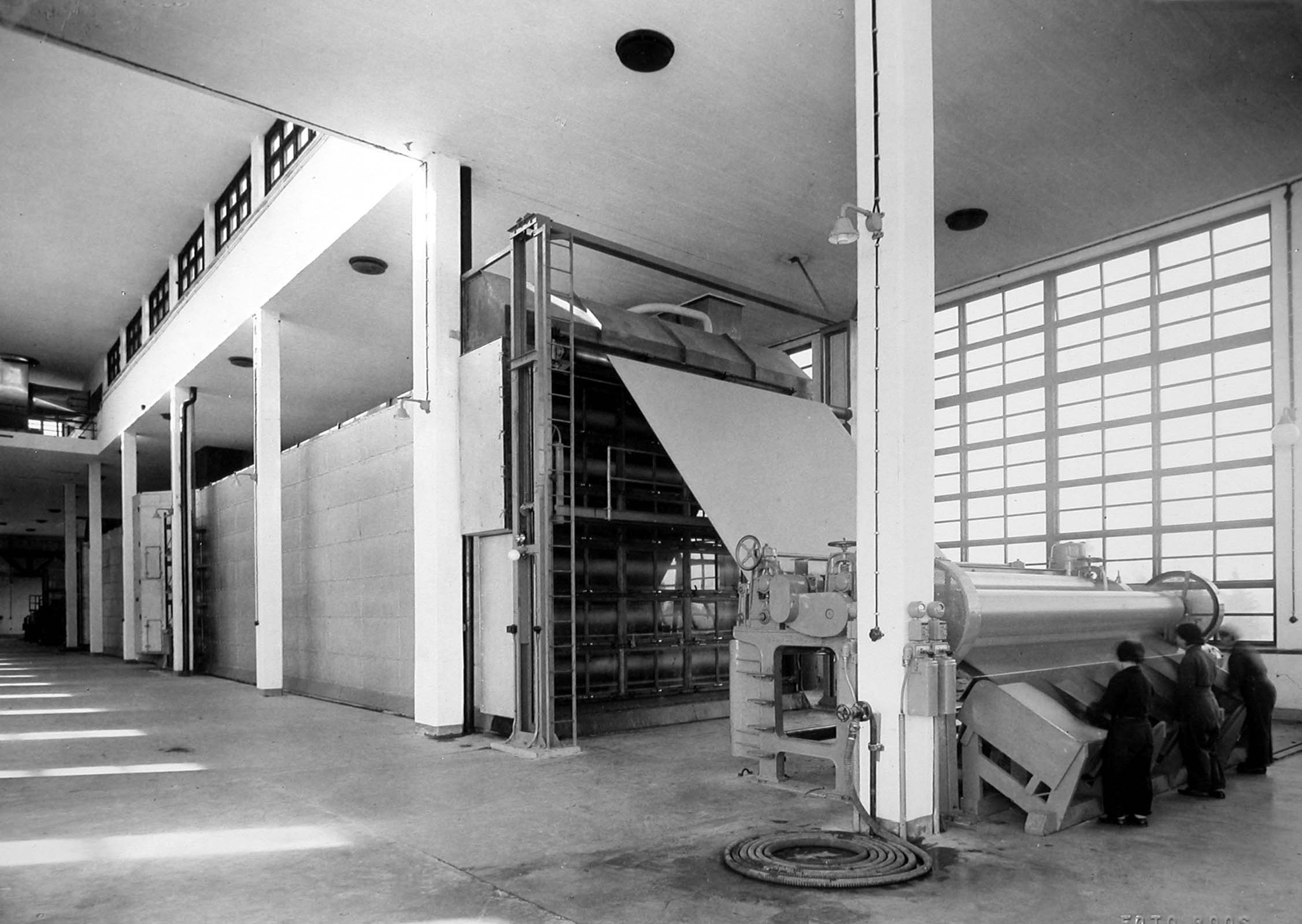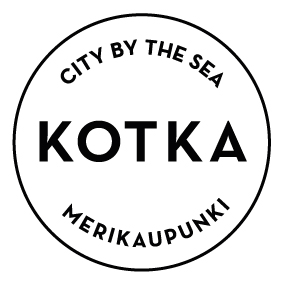The factory
The Sunila pulp mill becamean important symbol of industrialization and modern life. It was already on display while in construction at the Paris World’s Fair in 1937. Alvar Aalto also designed the Finnish pavilion for the 1939 World’s Fair in New York where Sunila was exhibited with photographs and a model.
Massive red brick structures rising on the island of Pyötinen form the framework of the architectural arrangement. The white-washed port warehouse, lime tower and the elevator tower of the digesting plant provide the counter-theme. In the photo above the Sunila pulp mill is pictured from the northwest.
The parabola shaped Glauber salt warehouse complemented the arch of the port warehouse, the external roof arches of the power plant along with the vertical supports and diagonals of the conveyors created a busy and diverse whole. In spite of additions, edits and changes made over the years the sea side face of the Sunila
pulp mill factory has more or less retained its unique and dynamic look.
On the side of facing the residential area, new steel silos and other process related structures dominate the view. All in all, the pulp mill today is a fascinating collage of structures made for production methods of different eras, where the original spirit is still present to this day.
In the beginning the planned production capacity of the Sunila pulp mill was 80 000 tons of pulp a year and after expansions 120 000 tons. Nowadays the annual capacity is 370 000 tons. At its peak, there were 1250 people working in the factory. Today, the pulp mill employs about 250 workers, but the numbers aren’t comparable since some functions have been externalized.
The interior of the office spaces in the Sunila pulp mill were designed by Aino Aalto and they have remained in their original condition.
Due to safety regulations, tours for architecture tourists cannot be organized inside the factory. An exception to this are the open doors days that the Sunila pulp mill organizes randomly.
“The new and old process construction in the pulp mill area intertwine into a fascinating technical collage.”
“Tehdasalueen vanha ja uusi prosessirakentaminen lomittuvat kiehtovaksi teknokollaasiksi.”
Kuva tehtaan konttorin alkuperäisestä interiööristä. KUVA © MAIJA HOLMA – ALVAR AALTO MUSEO
Sunila is part of the history of Finland’s industrialization
Sunilan saha maan puolelta kuvattuna. @ Kuvan omistaa Pentti Kirjavaisen perikunta
Before the pulp mill, there was a sawmill in Sunila along with the community that lived next to it. The sawmill was founded in 1875 and it was one of the nine sawmills that were established in the Kymi river delta during the sawmill rush in the 1870s. During the time of the pulp mill, this part of Sunila was called “Old Sunila”. The houses of this area were grouped mostly along both sides of the village road leading north from the sawmill. On the west side of the road were the houses of the sawmill manager, the foremen, machine operators, the teacher and the cashier along with the primary school. This side was called “the Swedish side”. The east side of the road was filled with the workers’ houses, the police and fire department buildings and the sawmill’s office. This side was known as “the Russian side”. Some of the buildings received nicknames such as “Rauhala”, “Siperia” and “Pappila” which were workers’ houses, “Härkätorppa” which was the bachelors’ house and the widow’s house “Onnela”. The northern area of Old Sunila known as “Koivuniemi” had a large sports field and many family houses. The sawmill also owned farmland along with the cowsheds, grain drying cabins and barns.
The Sunila company was a one-of-a-kind phenomenon in the history of industrialization in Finland. The company was founded in 1928 as a collaboration between seven wood processing companies. The company bought the Sunila sawmill and some of the lands surrounding it. Unfortunately, the great depression halted the plans before the project kicked off. The sawmill closed and Sunila quieted down for a few years. During the next economic boom the remaining five companies decided to found a shared pulp mill to provide their paper factories with raw material.
The building project started in 1936 and engineer Lauri Kanto, the technical manager from the pulp mill in Halla was invited to lead the project. He would also later become the first CEO of the Sunila company. The team that he gathered included Aulis Kairamo, a graduate engineer in charge of the technical design of the pulp mill and would later become the technical manager of the mill. The CEO of the A. Ahlström company Harry Gullichsen was chosen as the chairman of the Sunila company’s board of directors. He was the one to suggest the architect for the project, who happened to be his friend Alvar Aalto. Aalto had already gained popularity around the globe for his modern pioneer works such as the Paimio Sanatorium, the Office building for Turun Sanomat newspaper and the Alvar Aalto library in Vyborg. He had also already taken part in designing a pulp mill in Toppila, Oulu.
History of the pulp mill in photos
© Sunila Oy:n arkisto.
Aerial photograph of Sunila before the pulp mill. In the foreground is the island of Pyötinen where the mill was built. Behind it on the mainland you can see the Sunila sawmill. The residential area was built on the east side of the field in the middle.
© Kuva: Foto Roos 1.6.1938 – Sunila Oy:n arkisto.
The lime needed in the pulp making process was brought by train to the lime tower from where it was transferred to the digesters. The handling of the burnt lime was sweaty and stinging work. The upper and lower lime towers of the Sunila pulp mill.
© Kuva: Foto Roos 18.11.1938 – Sunila Oy:n arkisto.
After digesting the mass is portioned with the help of a turning pipe into the washing boilers that were placed in a ring around the digester.
© Kuva: Foto Roos 1.6.1938 – Sunila Oy:n arkisto.
In the final stage of the process the pulp came out of the drying machine in the form of a wide paper-like mat from which it was cut into sheets.
© Kuva: Foto Roos 1938. Sunila Oy:n arkisto.
A futuristic and almost sacral atmosphere in the Sunila pulp mill recovery plant. The energy is salvaged from the lye water by torching after the wood has been brokenup into fibres. The pulp making process is self-sustaining in terms of energy and can leave residual energy.
© Kuva: Foto Roo. Sunila Oy:n arkisto.
The pulp is ground in the muller.
© Kuva: Foto Roos 1938. Sunila Oy:n arkisto.
The tree bark is removed in the debarking plant.
© Kuva: Foto Roos 18.11.1938. Sunila Oy:n arkisto.
The woodchips are dropped from the attic to the boilers through funnels.
© Kuva: Foto Roos. Sunila Oy:n arkisto.
Builders on the stairs of the Sunila pulp mill July 3rd 1937.
© Kuva: Foto Roos 1.6.1938 – Sunila Oy:n arkisto.
The lime needed in the pulp making process was brought by train to the lime towerfrom where it was transferred to the digesters. The handling of the burnt lime was sweaty and stinging work. The upper and lower lime towers of the Sunila pulp mill.
© Sunila Oy:n arkisto.
The Sunila pulp mill illuminated by lightning.
© Kuva: Foto Roos. Sunila Oy:n arkisto.
The back of the dryer with its steam pipes.
© Kuva: Foto Roos 18.11.1938. Sunila Oy:n arkisto.
The control room of the power plant.
© Kuva: Foto Roos 18.11.1938. Sunila Oy:n arkisto.
The control room of the power department. The residential area is just one of the input sites.
© Kuva: Foto Roos 1938. Sunila Oy:n arkisto.
Bundles of pit props were transported from the wood field to the debarking plantvia cable conveyors. The lower conveyor made of concrete picks up the props straight out of the water.
© Kuva: Maija Holma, Alvar Aalto-museo.
The pulp mill pictured from the residential area in 2003. Nowadays mostof the process occurs in facilities outside of the old buildings. The original factory buildings are, however, preserved.
© Kuva: Trond Hedström 1963. Kymenlaakson museo.
The sodium sulfate needed in pulp making was stored in an arched hall cast fromconcrete. The cross-section of the hall is reminiscent of the shape that gravitycreates from the heaps of salt. The supporting ribs are located on the outside of the shell. The use of concrete to create curved and unrestricted shapes was a common habit among preoccupation of functionalist architects. Sodium sulfate has not been needed in years now and the weathered building has been demolished.
© Kuva: Foto Roos 23.3.1938 – Sunila Oy:n arkisto.
The building of the port warehouse March 23rd 1938. The ceiling arcs were assembled by nailing together planks.
© Kuva: Foto Roos 1.6.1938 – Sunila Oy:n arkisto.
Functionalism got its inspiration from the functional shapes of industrial buildings. When architects representing this current of thought commissions for industrial buildings, the result was often new and exciting architecture. Port warehouse and lower lime tower of the Sunila pulp mill.
© Sunila Oy:n arkisto.
The pulp mill at night.
© Kuva: Foto Roos 4.11.1938 – Sunila Oy:n arkisto.
The Sunila pulp mill pipe corridor November 4th 1938.
© Kuva: Trond Hedström 1963. Kymenlaakson museo.
The sodium sulfate needed in pulp making was stored in an arched hall casted from concrete. The cross-section of the hall is reminiscent of the shape that gravity creates from the heaps of salt. The supporting ribs are located on the outside of the shell. The use of concrete to create curved and unrestricted shapes was a common preoccupation among functionalist architects. Sodium sulfate has not been needed in years now and the weathered building has been demolished.
© Kuva: Foto Roos 1938. Sunila Oy:n arkisto.
The view from the digesting plant.
© Kuva: Foto Roo. Sunila Oy:n arkisto.
The interior of the factory.
© Kuva: Anna-Greta Kanto 1960-70-luku. Kymenlaakson maakuntamuseo, Matti Kannon kokoelma.
The woodchips are dropped from the attic to the boilers through funnels.
© Kuva: Rurik Wasastjerna
View to the office spaces of the pulp mill.

































